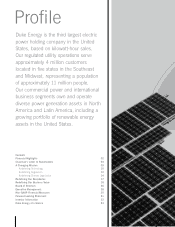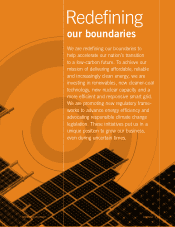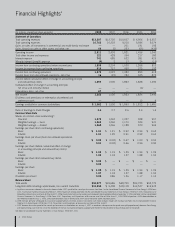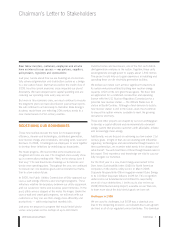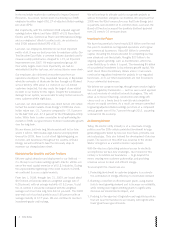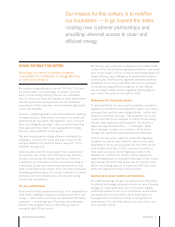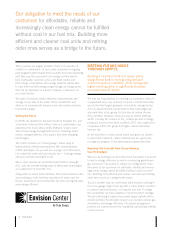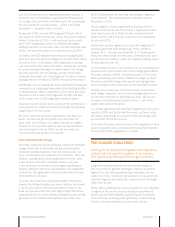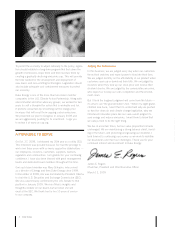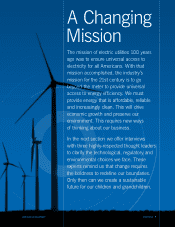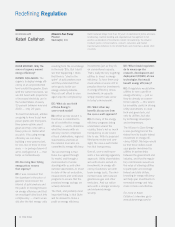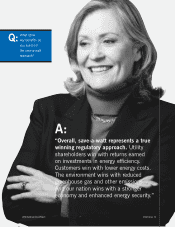Duke Energy 2008 Annual Report Download - page 6
Download and view the complete annual report
Please find page 6 of the 2008 Duke Energy annual report below. You can navigate through the pages in the report by either clicking on the pages listed below, or by using the keyword search tool below to find specific information within the annual report.
4 Duke Energy
in the real estate market also continued to impact Crescent
Resources. As a result, we fell short of achieving our 2008
employee incentive target of $1.27 of adjusted diluted earnings
per share (EPS).
But importantly, with the combined 2008 adjusted segment
earnings before interest and taxes (EBIT) of U.S. Franchised
Electric and Gas, Commercial Power and International Energy,
and our employees’ efforts to control costs, we achieved a
total 2008 adjusted diluted EPS of $1.21.
Last year, our employees delivered on our most important
metric of all. It was our best year ever for employee safety. Our
Total Incident Case Rate, a common industry standard used to
measure safety performance, dropped to 1.15, an 8 percent
improvement over 2007. All major operational groups hit
their safety targets. Even more importantly, we had no
work-related fatalities last year, and serious injuries were down.
Our employees also delivered an excellent year from an
operations standpoint. They responded heroically in September
when the remnants of Hurricane Ike tore through our Midwest
service territory. With about 1.1 million of our 1.6 million
customers impacted, this was easily the largest storm-related
incident in our history for this region. Despite the widespread
damage to our system, we were able to safely restore service to
every customer within eight days.
Last year, our stock performance was down but we still outper-
formed the overall markets. Duke Energy’s 2008 total share-
holder return was –21.7 percent, compared to –37.0 percent
for the S&P 500 and –27.2 percent for the Philadelphia Utility
Index. While there is some consolation in out-performing the
market in 2008, our goal remains to deliver sustainable growth
over the long term.
No one knows just how long this recession will last or how
severe it will be. With double-digit national unemployment
forecast for 2009, there is a lot of belt tightening going on
in homes and businesses throughout the country. At Duke
Energy, we will continue to take the necessary steps to
maintain our strong balance sheet.
Maintaining Our Liquidity and Cash Positions
Efficient capital attraction and deployment is our lifeblood —
it is the key to our future earnings growth. Electric utilities are
one of the most capital-intensive of all U.S. industries. During
the unprecedented tightening of the credit markets in 2008,
we continued to access capital markets.
From Jan. 1, 2008, through Jan. 31, 2009, we issued about
$4.5 billion of fixed-rate debt at a weighted average rate of
6.05 percent, with an average maturity of 15.2 years. To put
this in context, it should be compared with the weighted
average cost of our total long-term debt at year-end. The 2008
year-end cost of our total portfolio was 5.65 percent with an
average maturity of 12.7 years. We also continue to maintain
investment-grade credit ratings.
We will continue to allocate cash to our growth projects as
well as to maintain and grow our dividend. We are proud that
2008 was the 82nd consecutive year that Duke Energy paid
a quarterly cash dividend on its common stock. Last year, the
Board of Directors increased the quarterly dividend payment
from 22 cents to 23 cents per share.
Investing in the Future
We have the potential to invest nearly $25 billion over the next
five years to modernize our regulated operations and to grow
our commercial businesses. About $7 billion is committed
capital, including the dollars allocated for completing our two
new advanced coal-fired plants. Roughly $13 billion is for
ongoing capital spending, such as maintenance, which has
some flexibility as to when it is spent. The remaining $5 billion
of our potential investment is discretionary growth capital. We
won’t invest these discretionary dollars unless 1) we secure
constructive regulatory treatment for projects in our regulated
businesses, or 2) our return expectations are met for projects
in our commercial businesses.
We believe we can grow earnings through more creative legisla-
tive and regulatory frameworks — such as save-a-watt approval
and cash recovery of construction work in progress. This will
allow us to recover financing, construction and energy effi-
ciency costs on a timely basis to earn fair and competitive
returns on capital over time. As a result, we remain committed
to growing adjusted diluted earnings per share at a compound
annual growth rate of 5 to 7 percent through 2013, assuming
a rebound in the economy.
An Evolving Mission
Today, the electric utility industry is at a crossroads. Energy
policies over the 20th century promoted investment in large
generating plants fueled by low-cost fossil fuels, primarily coal
and natural gas. They also fostered the development of nuclear
power. The success of this effort was essential to the United
States’ emergence as a world economic superpower.
With the mission of providing universal access to electricity
accomplished, we face new challenges. Our mission for this
century is to redefine our boundaries — to go beyond the
meter, creating new customer partnerships and providing
universal access to clean and efficient energy.
To accomplish this mission we are:
1. Promoting investment in customer programs to accelerate
the contribution of energy efficiency to meet future demand
2. Building a new fleet of efficient power plants using diverse
fuels to meet growing demand and to increase our reliability,
while retiring older higher-emitting plants to significantly
decrease our environmental impact, and
3. Pushing for the approval of legislative and regulatory policies
that will ease the transition to an industry with significantly
fewer greenhouse gas emissions.


